 At over 4GHz, Intel's i7-4790K chip turns the volume knob to 11 for raw CPU performance.
At over 4GHz, Intel's i7-4790K chip turns the volume knob to 11 for raw CPU performance.
For 2014, Intel is introducing processors that have been additionally enhanced and tweaked for the enthusiast market more than with previous generations.
While a 4GHz Intel chip may seem an impressive in the decades long clock speed race, it actually is not that revolutionary and is more a sign of things to come milepost rather than the destination.
Background
As much as may want to, Intel cannot afford to ignore or alienate any of of its traditional core markets, in this case the Desktop PC market which includes several form factors of wired desktops such as Small Form Factor, All-in-One, Brand Name OEM, White box and DIY built systems. Desktop processors continue to be volume movers yet mobile chips for laptops are specially configured derivatives of these chips, whose existence is dependant on their desktop siblings. It also doesn't help that Top OEMs plus the Channel/DIY fan base are quite vocal and object any moves Intel (or AMD for that matter) make to attempt to change industry direction to the way that suits their business rather than user needs.
What people want and need is one thing, but technology wise Desktop and Mobile CPUs are essentially one and the same, it is just harder to market and sell a 'chip' to the world versus a complete retail and consumer friendly Laptop in this day and age where computing is ubiquitous and is now a 'need' not a 'want'. Mobility has been centre stage and public focus of Intel's various announcements for almost a decade now since the launch of the Original Centrino Notebook. With the proclaimed 'decline and death of the PC', complete ready made computing devices such as laptops, tablets and convertibles are easier to promote plus the market- both vendors and consumers now better relate and respond to products rather than raw technology.
Technical specs and low level innovation are becoming less relevant to a hungry market who are desperate for the 'next big thing', look at just the pillars that characterise a consumer device such as style,battery life, price and what's next rather than if there are any underlying technologies that are forward looking.
Gone are the days when the individual components of a computer were sourced from obscure vendors, came in plain boxes and with the absolute minimum of documentation.
Personal computing is more personal than ever, but this can mean different things to some users especially to the fervent Desktop/DIY crowd While mobility is an industry driver, new technologies and products for Desktops play second fiddle and are revealed either silently or at relevant events such as today's Computex Taiwan trade show which focuses on actual hardware, both low level components and finished products.
For its new high frequency and tuned for enthusiasts processors, Intel has tried to justify the health of the Desktop/PC segment that others claim 'is dying'. They are stating that customers demand desktops and that newer and smaller form factors are reinventing the segment, paired with lower prices and better specifications such as an emphasis on 4K resolution for All in One systems.
Playing their multi-touch card, enabling popular licensed board games from Hasbro such as Life, Scrabble and Risk is supposed to drive adoption of new AIOs featuring multi-touch screens. Nothing new here, popular licensed board games have been available on home computers PCs going back decades,such as on Texas Instruments machine. There will always be new ways to implement old, classic ideas.
As part of their announcement, Intel have cited recent analysts or independent bodies in attempt to use hard market data to justify the health of desktops for all uses whether business consumer or gaming.
- Gartner: Desktop seeing some recent improvements due to XP migration
- NPD: Desktop's March 2014 unit and dollar volumes increased 16 percent and 7 percent year-over-year, respectively.
- NPD: Small Form Factor (SFF) desktops experienced a 51 percent on-year increase to 18 percent share of desktop unit sales
- John Peddie Research: PC Gaming Hardware Revenue Increase from $20B in 2013 to $25B in 2016
- PC Gaming Alliance: PC Gaming Software Revenue Increase from $20B in 2013 to $25B in 2015
Plus the obligatory statement that with 27 million worldwide daily active users, League of legends is the biggest game out there.
Many of these statistics are based on software or hardware refresh cycles which occur every few years whenever here is some fundamental change in the software or hardware ecosystem that results in PC fleet renewals or upgrades.
Although the PC Gaming market itself is growing and is healthy, competition within the PC hardware segment itself is stagnant and vendors are extending product life cycles as long as possible. Optimisation for thermal and acoustic performance has become a priority over performance plus 2014 has seen the most expensive prosumer/gaming GPUs ever with the AMD Radeon R9 295 X2 and the NVIDIA GeForce Titan Z graphics cards ranging between $1500 and $3000. An additional technical complication is difficulties and delays seen with the development of new denser and smaller chip fabrication process from Globalfoundries, Intel and TSMC which compound the above issues, forcing vendors to consider product refreshes carefully.
The CPU State of Play for PC enthusiasts
This conservative and relaxed approach to product development is probably most evident with Intel and something which some PC enthusiasts feel hard done by. This is not necessarily a bad thing but when considering a product all aspects need to be looked at. Requirements of typical users, edge case users, market/industry, stakeholders and shareholders and the vendors internal requirements all need consideration.
With AMD now only making up 20% of x86 processor sales, Intel has no viable competition in the x86 space and has not 'taken things to the next level' as much it could have in an otherwise very competitive environment.
A company with such a monopoly would not need to put unnecessary development into a product which could risk success, realises sales are guaranteed and only does the needful, would not risk backlash over any caveats associated with aggressive specifications and would enable up-sell from mainstream parts to workstation/server class products for those who need performance. If you make your lower end or mainstream products too good then there is little need for high end products.
Power users and enthusiasts who want higher clock speeds and benefits from newer architectures have not really enjoyed these benefits for the past few generations due to the tick-tock development cadence. To gain a noticeable boost in performance and features users would have to wait a few years and jump one if not two generations of hardware.
Excluding any gains in performance thanks to a more efficient (powerful) processor architecture, the maximum clock speed of a processor is related to its voltage and if we risk power and temperatures going too far then the experience of the majority of users is negatively affected
Intel toed this line several years ago in the late Pentium 4 era with their desktop processors in order to stay competitive with AMD, then power users/enthusiasts complained 'they ran too hot' and still insist on this to this day.
In response, Intel went to a more efficient architecture, moderated their clock speeds and TDPs, relegating anything above 100 watts to workstation segment where such power is tolerated.
For 2nd gen core i5/i7 'Sandy Bridge' extreme enthusiasts enjoyed high extreme over-clocks, between 4.8 and 5.1GHz depending on the cooling used, they did so at the expense of power and thermals. Sandy bridge Desktop i7 parts were rated at a relatively low 95 Watts compared with previous chips.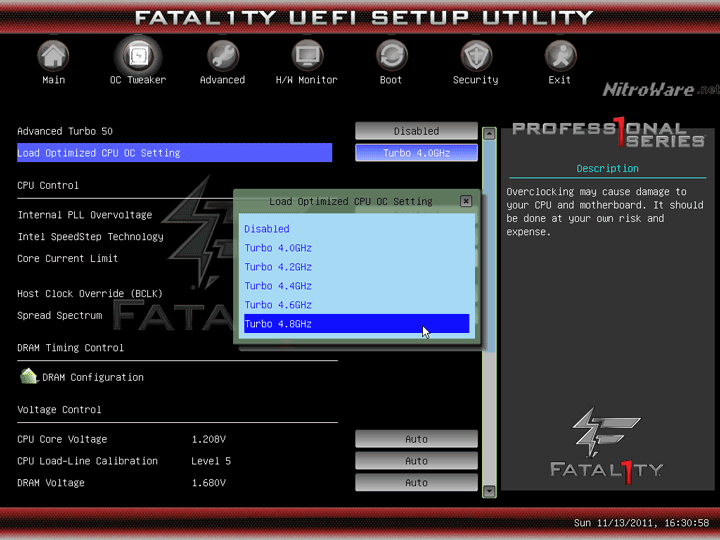
The next iteration, 3rd gen 'Ivy Bridge' was a die shink to 22nm die process and minor refresh of specs became every controversial to enthusiasts for its overclocking properties. In its default guise, Ivy introduced a reduction in TDP of almost 20 watts for some parts without compromising performance, but the denser chips affected overclocking.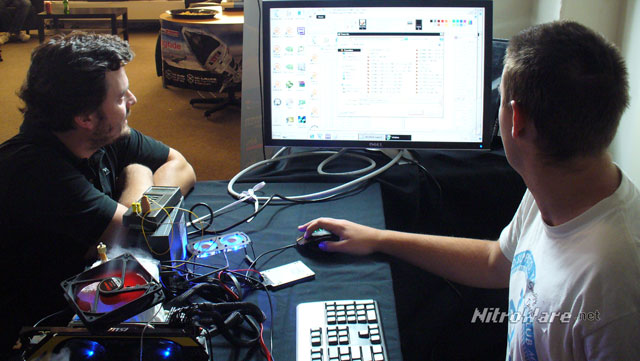
Its 160mm2 die despite being smaller ( and the 77W TDP ) packed in more transistors into the smaller die and lead to hotter running in some highly overclocked scenarios. This isnt really affect the 'typical' over clocker on air who was just after low 4 GHz, easily achievable with affordable air or liquid cooling, but those more extreme,competitive users who are after world records or acclaim within online communities.
One of the claimed reasons for the poor thermal performance was inferior thermal material used inside the CPU package. Some enterprising users did try to scientifically to prove this case but thermal density is still ignored by some. A minority of fervent enthusiasts continued to insist the silicon based thermal interface was the sole reason of this regression and cried foul of Intel since older different processors with a soldered lid had different thermal performance.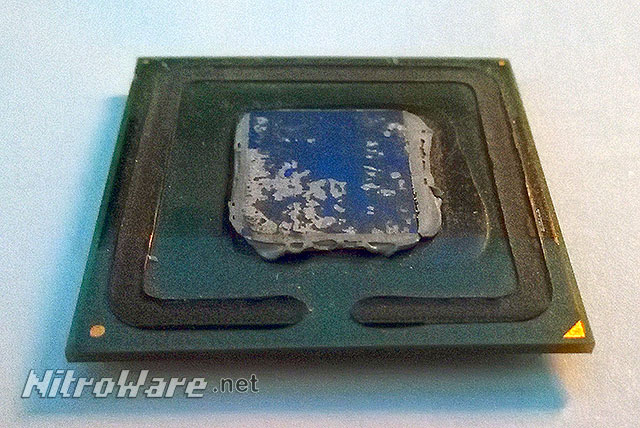
Upon release of 2013's 4th gen Haswell, TDPs went up again to 84W due to improved integrated graphics and integrated Voltage Regulation circuitry, each adding a few watts. One of the first things these die hard extreme enthusiasts checked on the new processors was the thermal material and cried out in disgust.
Evaluation samples of i7-4770K's reached about 4.6GHz at 1.3 volts which while is reasonable in itself, still not the magical high clockspeed numbers seen with Sandy Bridge.
Initial batches of production chips had trouble even reaching 4.6GHz which also didn't go down well with early adopter enthusiasts, again pointing fingers and crying foul of a lazy, incompetent or non caring Intel. To those with formal engineering, electronics or industry experience this desperation seemed almost comical as with every development in processor technology there are always caveats.
Vendors such as MSI even equipped their 9 series motherboard with a 'die saver' feature for those users who dangerously de-lidded their processor in desperation of the ultimate overclocking goal.
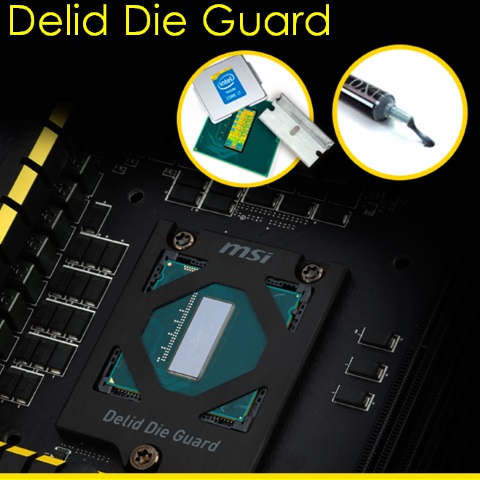
It seemed some at Intel have finally listened, do care about their dear desktop customers or even had enough of being criticised. Now that yields and binning of Haswell has improved 12 months down the track, combined with some packaging enhancements Intel is now able to offer overclockable clock speeds at low TDPs and zero price increase.
Binning refers to the selective grading of a semiconductor based on its electrical or thermal properties. Higher quality chips need less power and have less faults so are binned as higher performing parts.
For users who don't overclock seriously, or are just slightly curious, this boost especially on the i7 part negates the need to tweak. For those who do tweak, Total power will be lower and attainable clock speeds should be higher.
In the case of 'Devil's Canyon', Intel is making a statement to its customers that it listens and does care about raw performance. The packaging enhancements and market reaction both serve Intel as clever way testing future packaging technologies and tolerance of higher clockspeeds. Its a win-win for everyone. A large company does not establish a project and give it a codename for no reason.
This isn't the first time, Intel's optional over-clocking warranty which we covered previously also tested the waters, to see how reliable their processors are in the field when overclocked, as Intel themselves would have little internal data on how many processors are killed or discarded by extreme users.
Unlocked 4th Gen Intel® Core™ Processor Family Comparison
We will only be talking about the Core branded parts in this preview, a follow-up will cover Pentium lineage. The $72 Pentium G3258 'Anniversary edition' at 3.2GHz Unlocked belongs to a different product segment, has a different feature set and provide different performance than the core parts Here. For that part, the unlocked multiplier is more a convenience and a bonus rather than a feature that makes (or breaks) the product.
The Devil's Canyon codename and new logo is very apt. One could call the 4790K Intel's 'shock and awe' processor, with 500MHz for no additional price and only four watts more. When AMD tried the same approach in 2013 with their FX-9000 series 4GHz range processors, the processors were a failure in the eyes of the technical press and end users, both for the processor's power and thermal specifications and pricing. Intel has not made the same mistakes.
| Part | Base Clock (GHz) | Turbo Clock (GHz) | Cores/Threads | Cache | Graphics | Memory | TDP | Socket | Price |
|---|---|---|---|---|---|---|---|---|---|
| Core i7-4790K (NEW) | 4.0 | 4.4 | 4/8 | 8MB | HD 4600 1250 MHz | Dual channel DDR3-1600 | 88W | 1150 | $339 |
| Core i7-4770K | 3.5 | 3.9 | 4/8 | 8MB | HD 4600 1250 MHz | Dual channel DDR3-1600 | 84W | 1150 | $339 |
| Core i5-4690K (NEW) | 3.5 | 3.9 | 4/4 | 6MB | HD 4600 1200 MHz | Dual channel DDR3-1600 | 88W | 1150 | $242 |
| Core i7-4670K | 3.4 | 3.8 | 4/4 | 6MB | HD 4600 1200 MHz | Dual channel DDR3-1600 | 84W | 1150 | $242 |
Apart from clockspeeds and TDP no other changes have been made to he processors. Official DDR3-1866 support is still reserved for AMD or Ivy Bridge-E/EP processors, not that it is needed. Though Engineering samples of the original 4770K and Intel's own Z87 motherboard had issues with 2400 MHz memory.
The main physical change to the new processors are new thermal material between the processor die itself and the nickel-copper lid that acts a heat spreader. The new buzzwordy material is just that and until an updated processor datasheet is available or chemical analysis is performed, we cannot infer anything from this.
The only way to tell if this change affects performance is to do a side by side comparison of temperatures of a 4790K configured to run at the same speed as a 4770K.
In addition to thermal bonding, the typical passive components, resistors and capacitors found on the bottom of the processor package which terminate signals, assist power delivery and set options have been redesigned, not just additional capacitors added as Intel has claimed.
Looking at the side by side picture, for the original processor we can see groupings which may correspond to the number of physical cores but they comprising of only a few passives. There are many unpopulated solder pads reserved for future use.
For the new Devil's Canyon processors, horizontal arrays of capacitors have been added which clearly correspond to each of the four cores. It is unclear if any enhancements have been made to the Integrated Voltage Regulator to complement this. It will be interesting to compare the Voltage ID tables between processors to see if the extra performance is at cost of some voltage bumps.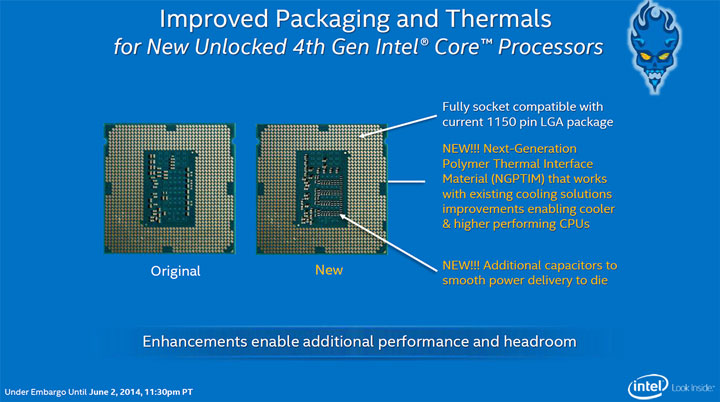
For launch, Motherboard vendors such as ASUS and ASrock have begun to support these new processors via means of a BIOS update. For ASUS Z87 boards, the update package an Intel management engine (ME) firmware update is included in addition to the BIOS update. The instructions state to apply the ME update first,likely to prevent any issues on first boot after the BIOS update.
Performance
Samples were not available at launch time, Intel has told us to expect these first half of June. But we don't actually need a sample to determine performance at 4 to 4.4 GHz as we know what benchmarks do in this ballpark already.
With no other features or architectural differences, performance at stock can be somewhat accurately estimated using existing 4770K over clocking data. In our case we achieved 4.6 GHz with our Engineering Sample Haswell 4770K and Z87 motherboard at launch time. The caveat of this run was temperatures, up to 100c under load which is typical for a modern Intel processor with cores running at around 1.3 volts.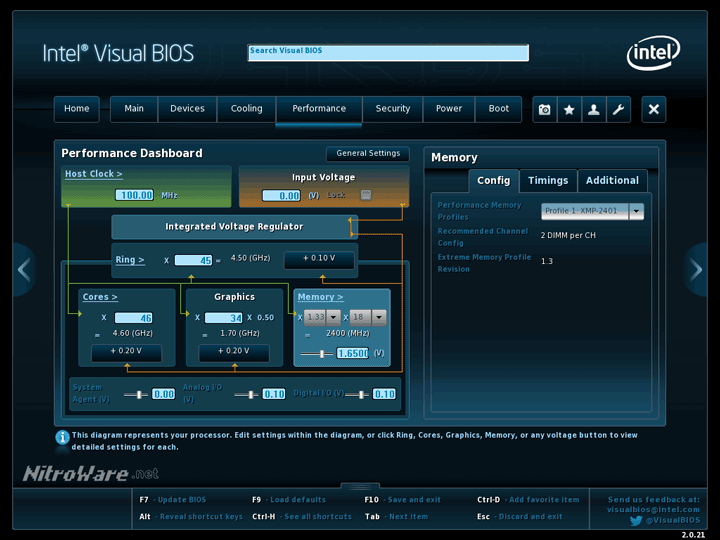
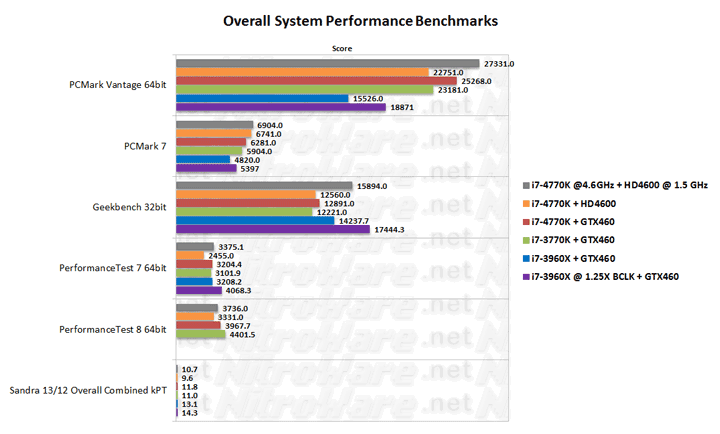
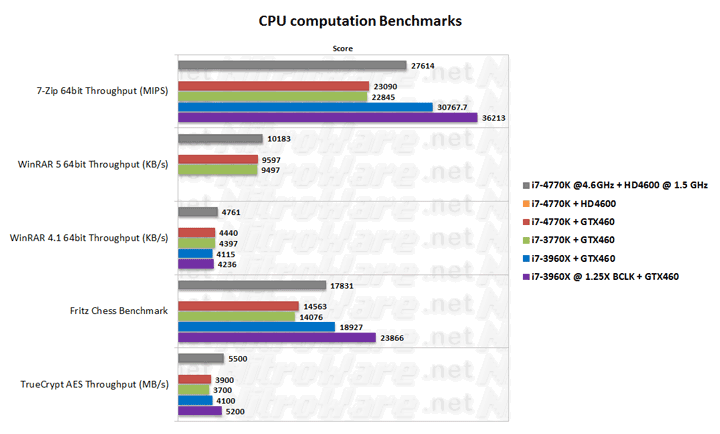
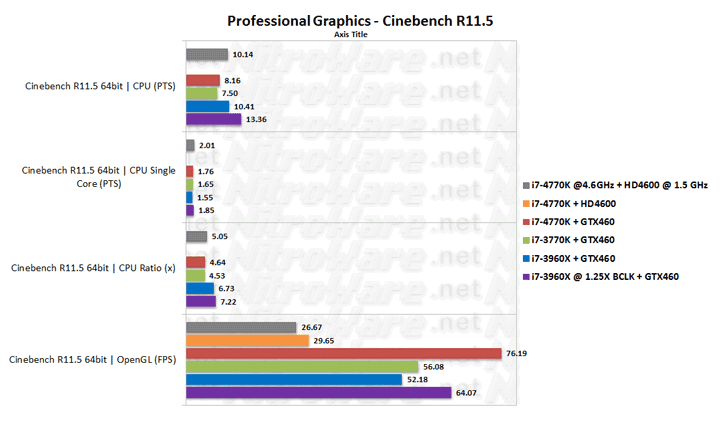
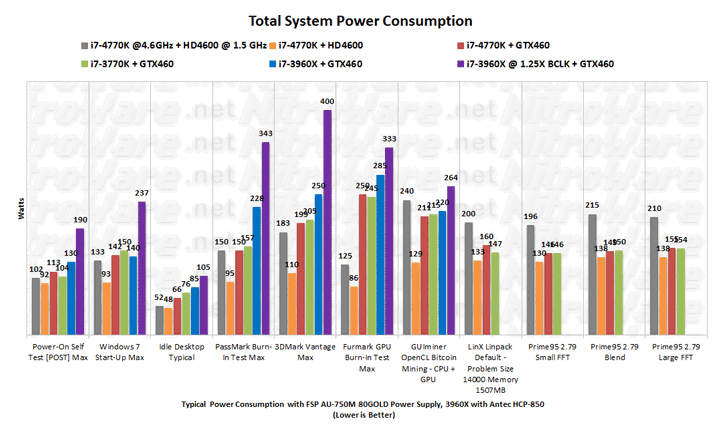
Although we stated the 4790K will have a all core speed of 4GHz and a single core turbo speed of 4.4GHz this is not entirely true:
Intel Z series motherboards when paired with a K series unlocked processor will run these chips at higher speeds, thanks to the turbo boost feature.
Intel markets both the i7-3770K and i7-4770K as 3.5 to 3.9 GHz processors, however the 3.5 here is actually the base guaranteed minimum speed for the processor regardless of whatever system it is installed in, whether it is a Dell Desktop, System Builder Whitebox or a semi server.
The bonus speed comes in two forms, what Intel supports directly and what they don't.
The former is that when installed in certain motherboards, these 3.5 GHz parts will actually run at 3.7GHz for all cores. 3.9GHz single core turbo is unchanged. Technically this is over-clocking, but this setup is described by Intel in their technical documents and is still within the operating specifications for the processor and fully covered by warranty. Even Intel's OWN Z87 motherboard exhibits this behaviour. This behaviour cannot be overridden except with manual tweaking of the processor settings in the motherboard BIOS.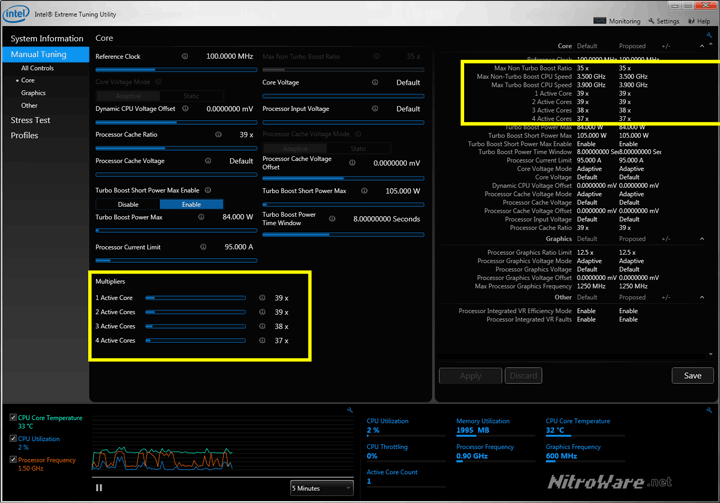
The advertised speed of some Intel processors is actually their worst case, non-turbo boost speed
Using this rationale, the i5 4690K part should gets a +200MHz boost and the new 4790K should also get a boost to 4.2GHz however We won't know for sure until we actually boot one up.
The second speed-up comes from certain mobos offering a feature called "Multi Core Enhancement" which overwrites the default CPU Turbo Mulitpliers and forces the highest turbo speed , eg 39x for to all cores rather than just one core. This behaviour is not supported by Intel and will run the processor out of specification and much hotter, but does not present any danger to the processor. Third-party processor cooling is recommended.
If we take all cores at 4.2 Minimum Turbo speed, or all cores at 4.4 (MultiCore Enhancement) then these speeds are impressive given the necessity to overclock a 3770K or 4770K to reach these clocks anyway.
Verdict
With the new parts coming in at the same list price as their 2013 predecessors, power users and enthusiasts who desire an unlocked CPU will gain extra performance at no extra cost. Both the new i5 and i7 are well under 95W TDP so thermals should be in check
There is nothing inherently wrong or bad about these parts themselves, but what needs to be considered is their timing and place in Intel's Roadmap for the next 12-18 months.
'Codename: Devils Canyon' is a blip on the radar, a stop gap if you will while Intel works on its now delayed 14 nanometre die shrink process and its 5th generation Broadwell family of processors. The new packing features we have mentioned in this article will very likely be used for future socketed Intel Processor and this release serves as a pilot program/pipe-cleaner/experiment whatever term you want to call it in the meantime.
A unlocked, socketed Broadwell processor has already been announced for release some time in the future, estimates now look at 1st to 2nd Quarter 2015 and the part will be compatible with the Z97 chipset. This part will not only be 14nm, it will also have the Crystalwell technology L4 cache and any new enhancements and features that make up the Broadwell family.
The 2015 roadmap is not all, In the 2nd half of 2014 Intel's Extreme Enthusiast/Workstation/Server products will be also refreshed, offering Extreme Enthusiasts and Professionals 6 and 8 core processors.
While 4 to 4.4 GHz for Intel chips might sound great on paper or while reading this story, one needs to remember these speeds are already achievable on existing processors. However currently these speeds are only achievable while overclocked and as a result there is higher temperatures and a significant increase in power draw.
What Devils Canyon now gives us is the 4+GHz level of performance at 'stock' Thermal Power, that's all.
So who is this processor for?
- Those who are in the market for a Unlocked Haswell CPU and not yet purchased
- Those who want 4+ GHz without hassle or 'risk' of overclocking
- Smaller Form Factor builds where thermals are more of a concern
Who is this processor not for?
- Those waiting for the next best thing, this is not it
- Those who already have a Haswell based i5 or i7 or even an Ivy Bridge based i5/i7
- Users wanting to migrate from X58 or X79 'based' Extreme systems. Those users have specific needs which are best served by upcoming X99 platform.
I commend Intel on what they have done delivering these 4+ GHz at 88W TDP and no cost to the end user. Plus the new i5-4690K delivers 4770K clock speeds minus Hyper-Threading technology and some cache memory at the $250 mark. Not a huge boost but great for those on a budget.
This release goes somewhat to resolving claims that both AMD and Intel have been too conservative with performance lately.
Devil's Canyon brings performance that was once relegated to the PC overclocking elite to the average power user who has little or no desire to tweak their system. Thanks for listening Intel, but enthusiasts have also asked for Crystalwell technology L4 cache on a performance processor which won't be able available until 2015's Broadwell-K.
Three questions now remain which will define what is in store for mainstream desktop computing for the next 12-18 months:
- How these enhanced parts overclock and if 5+GHz is attainable at reasonable temperatures?
- How timely will Broadwell based Desktops CPUs be?
- What will AMD's answer to Devil's Canyon be, if any?